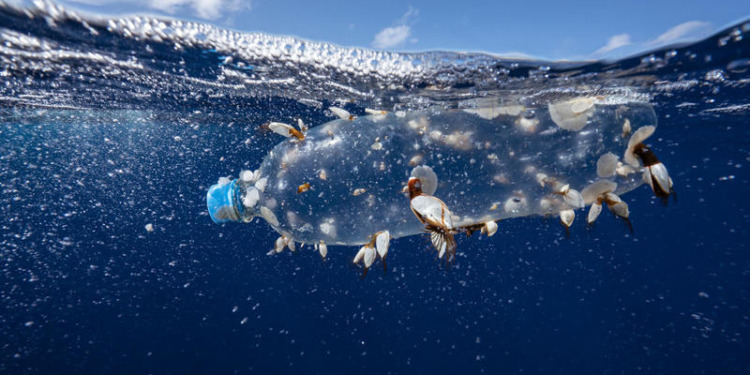A recent study published in the Nature Ecology & Evolution journal on April 17 revealed that the Great Pacific Garbage Patch is now home to new mixes of coastal and pelagic (open sea) species that are interacting and living on the plastic debris.
The Great Pacific Garbage Patch is possibly the greatest current piece of evidence of our disturbance to marine ecosystems. Also referred to as the Pacific trash vortex, the patch of anthropogenic debris covers 620,000 square miles of the ocean halfway between California and Hawaii, an area three times the size of France!
The Patch is bounded by the North Pacific Subtropical Gyre, which refers to a large system of spinning ocean currents. Plastic waste that is disposed of in the ocean gets dragged into this gyre by the currents, and consequently the ‘Pacific trash vortex’ is formed.
The most common misconception about the Great Pacific Garbage Patch is that it is a visible lump of trash floating in the sea. In reality, the area is comprised of many patches which are almost entirely made up of microplastics, minuscule pieces of plastic that aren’t usually visible to the naked eye.
Even satellite images do not show a giant patch of debris; the water just looks cloudy, and this cloudy water is intermixed with larger debris such as shoes and fishing equipment.
When we consider that 70% of marine debris sinks to the ocean floor, it is also possible that the Great Pacific Garbage Patch could be an underwater trash heap.
This terrifying amount of marine debris is extremely damaging to the creatures in close proximity to it. For example, loggerhead sea turtles are often killed after they consume plastic bags, which are similar in appearance to their favourite food, jellyfish.
In addition, albatrosses often mistake plastic resin pellets for fish eggs and feed them to their chicks, which then tragically die of starvation or ruptured organs.
Moreover, the Great Pacific Garbage Patch has also disrupted ecosystems by transplanting and displacing species. The new study published on April 17 shows that coastal species like jellyfish have been carried out into the ocean by the plastic debris, and are now competing with the native pelagic species on the garbage patch, creating new unnatural neighbourhoods that the study refers to as “neopelagic communities.”
Extent and reproduction of coastal species on plastic debris in the North Pacific Subtropical Gyre https://t.co/ncnOnjBVX8
Haram et al report evidence that coastal taxa are living and reproducing while rafting on #plastic in the Great Pacific Garbage Patch pic.twitter.com/iDmDO9pqCT
— NatureEcoEvo (@NatureEcoEvo) April 17, 2023
Linsey Haram, a science fellow at the National Institute of Food and Agriculture and the study’s lead author, told CNN:
“Quite a large percentage of the diversity that we found were coastal species and not the native pelagic open ocean species that we were largely expecting to find…On two-thirds of the debris, we found both communities together… competing for space, but very likely interacting in other ways.”
Related Articles: The Sustainable Development Goals and Fighting the Plastic Soup | 4 Ways to Reduce Plastic Pollution
70% of the debris analysed by the researchers contained at least one species usually found in coastal waters. Creatures such as sponges, worms, and jellyfish were found mixing with native pelagic species, competing with them for space and for food.
The plastic debris that sustains these neopelagic communities will only expand in the coming years, causing more and more disruption to marine life.
According to the United Nations Environment Programme (UNEP), the world produces around 460 million tons of plastic a year, a figure that will triple by 2060, unless urgent action is taken to reduce plastic production.
The Great Pacific Garbage Patch is just the beginning, and the horrific damage to our oceans evidenced by the Patch will only increase unless a great change is enacted.
Last year, the UN Environment Assembly pledged to end plastic pollution and create the world’s first global plastic pollution treaty by 2024 – a legally binding agreement that would assess all stages of the life cycle of plastic, from its production and design to its disposal.
However, will this be enough to solve one of the most pressing and difficult problems that the planet has ever experienced?
Despite the intimidating amount of plastic debris, positive impacts have been made in the last few years which can provide hope that one day, as a planet, we can solve our plastic problem.
For example, The Ocean Cleanup, founded in 2013 by Dutch inventor and entrepreneur Boyan Slat, has been cleaning the Great Pacific Garbage Patch with the aim of removing 90% of floating ocean plastic by 2040.
So far, over The Ocean Cleanup’s first 12 trips to the Great Pacific Garbage Patch, the organization removed 193,832 kg of plastic from the ocean, and this is just the beginning of their positive work for the planet. As more awareness is raised about the detrimental impact of our plastic waste on our oceans, we can only hope that more initiative is taken to both clean up the existing debris and prevent further pollution.
BREAKING: 200,000 kg of plastic extracted from the Great Pacific Garbage Patch.
System 002/B has made its first extraction of 2023 – 6260 kg of plastic out of the GPGP, bringing us to an exciting milestone – together, we have cleaned up over 200,000 kg of plastic from the GPGP. pic.twitter.com/wkc0IAW3dl
— The Ocean Cleanup (@TheOceanCleanup) April 4, 2023
Editor’s Note: The opinions expressed here by the authors are their own, not those of Impakter.com — In the Featured Photo: A clear plastic bottle is found drifting in the garbage patch. Living on this single bottle were bryozoans, nudibranchs, crabs, and barnacles. Featured Photo Credit: © Justin Hofman / Greenpeace










